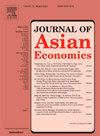Trade liberalization and elderly health: Evidence from micro-level data
IF 2.9
3区 经济学
Q1 ECONOMICS
引用次数: 0
Abstract
In the context of an aging population, studying the impact of international trade liberalization on elderly health is an important topic. Based on the China Health and Retirement Longitudinal Study (CHARLS) data from 2015 and 2018, combined with customs tariff data reflecting the trade liberalization level, and using geographical distance as an instrumental variable to address endogeneity issues, this paper empirically tests the impact of import trade liberalization on elderly health and its underlying mechanisms. The study reveals that import trade liberalization significantly improves elderly health, as measured by the prevalence of chronic diseases, and the results are robust. The effects are more pronounced in the elderly who are married males, aged 60–74, have a higher education level, poorer health and cognitive abilities, lower wealth, and reside in central, eastern, and coastal regions. Further mechanism analysis uncovers that import trade liberalization primarily improves elderly health through four pathways: increasing imports of medical products (e.g., medical devices and personal protective equipment), improving environmental quality, enhancing public healthcare service provision (e.g., regional government healthcare expenditure, the number of healthcare institutions, health technical personnel, and patient beds) and elevating the income levels of the elderly.
贸易自由化与老年人健康:来自微观层面数据的证据
在人口老龄化背景下,研究国际贸易自由化对老年人健康的影响是一个重要课题。本文基于2015年和2018年中国健康与退休纵向研究(CHARLS)数据,结合反映贸易自由化水平的关税数据,以地理距离为工具变量解决内生性问题,实证检验了进口贸易自由化对老年人健康的影响及其机制。研究表明,进口贸易自由化显著改善了老年人的健康,以慢性病的患病率来衡量,结果是稳健的。这种影响在年龄在60-74岁、受教育程度较高、健康和认知能力较差、财富较低、居住在中部、东部和沿海地区的已婚男性老年人中更为明显。进一步的机制分析发现,进口贸易自由化主要通过四个途径改善老年人健康:增加医疗产品(如医疗器械和个人防护装备)的进口,改善环境质量,加强公共医疗服务提供(如地区政府医疗支出,医疗机构数量,卫生技术人员和病床数量)和提高老年人的收入水平。
本文章由计算机程序翻译,如有差异,请以英文原文为准。
求助全文
约1分钟内获得全文
求助全文
来源期刊

Journal of Asian Economics
ECONOMICS-
CiteScore
4.70
自引率
9.40%
发文量
90
期刊介绍:
The Journal of Asian Economics provides a forum for publication of increasingly growing research in Asian economic studies and a unique forum for continental Asian economic studies with focus on (i) special studies in adaptive innovation paradigms in Asian economic regimes, (ii) studies relative to unique dimensions of Asian economic development paradigm, as they are investigated by researchers, (iii) comparative studies of development paradigms in other developing continents, Latin America and Africa, (iv) the emerging new pattern of comparative advantages between Asian countries and the United States and North America.
 求助内容:
求助内容: 应助结果提醒方式:
应助结果提醒方式:


